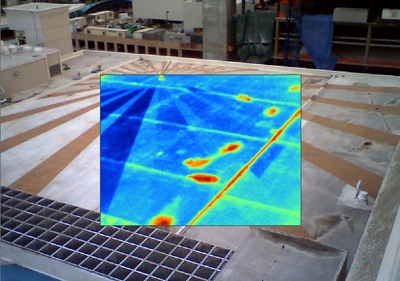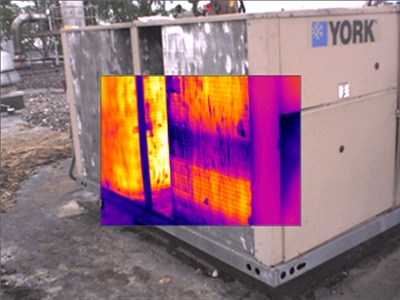Top six places for energy losses in commercial buildings
Monday, 17 June, 2013
A considerable amount of energy loss in commercial buildings is temperature related. An obvious issue is hot or cold air leaks, but many other systems and pieces of equipment also waste energy in terms of heat.
Unlike regular digital cameras that capture images of the visible light reflected by objects, thermal imagers create pictures by detecting infrared energy or heat. The thermal imager then assigns colours based on the temperature differences it detects.
With a small amount of training, most people can use a thermal imager to readily spot abnormal heat flow patterns and follow the heat trail to find the source of the energy waste. The technique works best when used by people who already possess a good working knowledge of the structures and systems being scanned so that they can better interpret the temperature variances they see on camera.
Fluke Australia has provided a list of the top six places to look for energy losses in commercial buildings together with details on how to detect these leaks using a thermal imaging scanner.
1. Building envelope
The ‘building envelope’ refers to the building structure as well as the climate controls within it. The envelope is what separates the outside environment from the inside and it’s frequently imperfect.
The problem with building envelope inspections is that the degree of temperature variance detected may often be very small, only a few degrees in some cases.
The best time to scan is during a heating or cooling season when there is a large difference in temperature.
Similarly, beware of solar loading, wind, precipitation and other environmental factors which could mask or distort potential problems. For instance, be careful to understand the direction and amount of heat flow when scanning an exterior wall if the sun is shining on it.
What to scan
- Roofs - Wet roofing insulation loses much of its R-rating. This means heat can escape or enter the building much easier through wet insulating materials. In addition to looking for moisture issues, scan the roof surface and follow temperature differences to possible air leak entry/exit points.

- Walls between conditioned and unconditioned spaces, including outside walls - Due to the natural flow of air with different temperatures, significant air leaks tend to occur at the top and bottom of conditioned spaces, where air either enters or escapes a structure.
- Construction joints and connections - For example, at floor slabs that extend outdoors there are often heating or cooling losses by conduction through the slab.
- Penetrations of the building envelope such as pipes, conduits and chimneys - Uninsulated or unsealed gaps often exist around roof and wall penetrations.
- Door and window frames and seals - Locate air leaks around windows and doors caused by worn or missing seals.
2. Boilers
Boilers are the heart of steam and hot water heating systems.
What to scan
- Refractory and insulation - Thermal imaging makes the in-service monitoring and inspection of the condition of refractory linings for performance issues possible.
- Fan motors - As with motors in other applications, check for impeded airflow, electrical unbalance, overheated bearings and failing insulation.
- Pumps - Look for hot bearings, leaking seals and, as with fans, motor faults.
- Valves - Thermal imagers can identify blocked valves that are nominally open and leaking valves that are nominally closed.
- Electrical connections - As with other kinds of systems, look for loose or corroded connections that increase resistance.
3. Motors and generators
Electric motors are one of the biggest energy consumers in any facility. Overheating and malfunctioning motors and generators tend to indicate mechanical or electrical inefficiencies that lead to unnecessary energy use and sometimes even failure. Since generators are, in a sense, ‘reverse motors’, diagnostics are similar for both kinds of units.
What to scan
- Airflow - In fan-cooled motors, restricted airflow can cause general overheating often manifesting itself on the entire housing.
- Electrical unbalance - A common cause, a high resistance connection in the switchgear, disconnect or motor junction box can usually be pinpointed by an infrared inspection and confirmed using a multimeter, clamp meter or a power quality analyser.
- Bearings - When thermal images reveal bearing housings with abnormally high temperatures, either lubrication of the bearing or its replacement is often called for. Beware that over-lubrication can cause abnormal heating as well.
- Insulation - Look for higher than normal housing temperatures in areas associated with windings. For each 10°C rise over the maximum rated temperature of a motor, approximately half the life of the motor is lost due to insulation failure.
- Electrical connections - As with electrical connections in HVAC systems, look for loose or corroded connections that increase resistance. Heat losses due to high-resistance connections means that your energy is being given off as heat instead of being used for useful work.
4. Steam heating systems
Today, steam systems are more common in industrial settings than commercial settings, but some commercial buildings still use them for central heating.
Where to look and what to look for
- Steam traps - Check traps using both thermal imaging and ultrasonic testing. Each technology works better than the other for certain traps and trap configurations.
- Radiator coils - Check for obvious steam leaks in radiators and at all visible pipe and joint connections.
- Steam lines and valves - Look for signs of leaks and blockages and for blow-by at valves that are supposed to be ‘closed’.
- Condensers - Look for leakage of outside air, which reduces the condenser’s vacuum, thereby decreasing its efficiency.
5. HVAC system
The heating, ventilation and air conditioning (HVAC) system is usually one of the biggest energy consumers within a facility.

What to scan
- Ductwork and registers - Even the highest rated HVAC system wastes energy without a well-sealed duct system. With thermal imaging one can see the thermal pattern of air loss or gain in ducting and also monitor registers to determine whether heating or cooling output is optimal.
- Fans and blowers - These mechanical elements are, of course, motor driven. In fans and blowers, mechanical imbalance will manifest itself in overheated bearings and other components. Thermal images of these systems can also identify shaft misalignment in couplings between the motor and fan.
- Electrical connections - Loose or corroded connections increase resistance at the connection point, resulting in increased energy costs.
- Compressors and coils - Regular inspections of the compressors and coils can also help reduce energy costs. A malfunctioning compressor can have a different thermal signature than a properly operating one. If coils are blocked or cooling fins are clogged, improper airflow and heat exchange can take place. This can greatly impact system efficiency and also further reduce component lifespan.
6. Electrical system
Many people don’t realise that electrical systems can actually waste money. As components degrade and resistance increases, waste occurs.
What to scan
- Distribution panels - Check for unbalance in circuits and loose and corroded connections at breakers, contacts, fuse clips and buss work.
- Transformers - Be aware that if the temperature of one electrical leg on a transformer is significantly hotter than the others, that leg may be failing.
- Lighting control circuits - Check all wiring splices and connections at fuses, switches, in panels and at the fixtures. Be aware that thermal imaging can also be used to monitor low-voltage control circuits.
As the price of thermal imagers has come down, it is claimed that most facilities can now recoup the cost of purchase in terms of energy savings within six months. Incorporating infrared inspection into regular maintenance in commercial buildings can provide significant energy efficiencies and also help to identify and prevent expensive failures.
Partnership brings innovative fuel solutions to Gippsland
A study by European Energy Australia and Opal at the latter's Maryvale Paper Mill will assess...
Data centres — a missed opportunity for sustainability
The question is no longer whether we need data centres, but how we plan, locate and govern...
Sodium-ion battery may provide greener energy
Scientists say sodium-ion batteries may be the answer to the future of sustainable energy storage...








